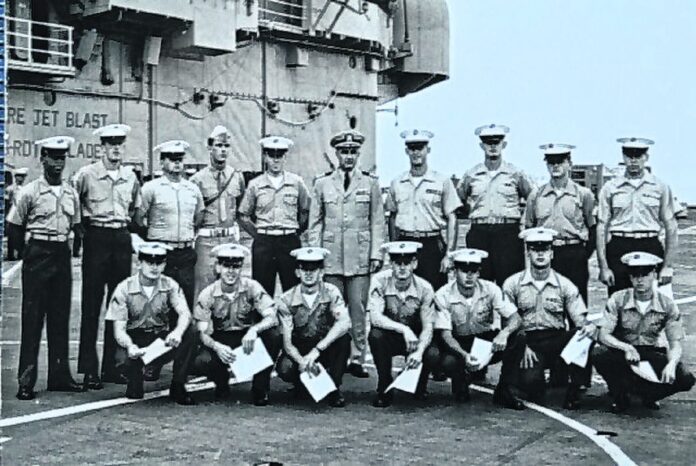
A Marine veteran from Hope had a unique front-row seat to one of the most defining moments of the 20th century, helping ensure the safe return of Apollo 11 astronauts Neil Armstrong, Edwin “Buzz” Aldrin and Michael Collins after their trip to the moon.
As the nation commemorates the 50th anniversary of the Apollo 11 moon landing today, Sgt. Vance Hege, 70, looks back on meeting the astronauts and watching President Richard Nixon welcome the heroes back to Earth.
It was July 24, 1969 — just four days after Armstrong became the first human to step foot on the moon — and Hege, who was 20 years old at the time, said he was standing on the hangar deck on the port side of the USS Hornet aircraft carrier, which had been dispatched to the Pacific Ocean to pick up the Apollo 11 astronauts.
Hege was approximately 812 nautical miles southwest of Hawaii, scouring the sky in search of Command Module Columbia, which was carrying Armstrong, Aldrin and Collins. The command module was expected to splash down near the ship, marking a dramatic end to a four-day, 238,900-mile journey.
[sc:text-divider text-divider-title=”Story continues below gallery” ]Click here to purchase photos from this gallery
“I watched it come out of the sky,” recalled Hege, referring to the command module. “Have you ever seen a falling star? That’s what it looked like when it came down. It was just like a falling star.”
When the command module had fallen to an altitude of around 10,000 feet, three parachutes deployed to slow the module’s rate of descent from around 175 miles per hour to approximately 22 miles per hour, according to the U.S. National Air and Space Museum’s website. After the module splashed down, a team of Navy servicemen swarmed the module and brought the astronauts on board the USS Hornet.
Though millions of people around the world celebrated the successful mission and humanity’s first steps on the moon, the astronauts did not get to immediately join in. Instead, they were whisked away into a mobile quarantine facility housed on board the USS Hornet because U.S. officials were worried that the astronauts might have transported lunar pathogens back to Earth.
The quarantine facility was a 35-foot-long, 9-foot-wide aluminum trailer designed to prevent the astronauts from spreading any moon germs, according to the U.S. Air and Space Museum’s website.
Hege, a 1967 graduate of Hauser High School, was one of a few U.S. Marines tasked with ensuring nobody entered or exited quarantine.
The trailer contained living and sleeping quarters for the astronauts, as well as a kitchen, bathroom and, on one end of the facility, a glass window with a curtain. The three astronauts and one physician stayed in quarantine for 88 hours while the USS Hornet made the nearly 900-mile trek to Pearl Harbor Naval Base in Hawaii.
Typically, one Marine was stationed on each side of the facility for four hours at a time, Hege said. The facility was guarded 24 hours per day.
“We rotated, we walked around,” Hege said. “That’s how you broke up the four-hour shifts. You could march back and forth and kind of stretch your legs out. You could do stuff. Come to attention. You could move around a little.”
“(The astronauts) kept the curtain pulled, generally,” Hege added. “But every now and then they’d look out and give you hand signals. It kind of depended on what they were in the mood for. Us being Marines, we’d look at them and smile. That’s about all we could do.”
However, one of the officials in charge of Hege’s contingent attempted to communicate with the astronauts via drawings, Hege said.
“They drew pictures of Snoopy on the moon with an American flag,” Hege said. “I remember that, and (the astronauts) thought that was funny. They laughed and giggled. Then they held up a (message) that said, ‘Thank you for your service,’ or something like that.”
One particularly notable moment of the Hege’s assignment on board the USS Hornet was when President Richard Nixon welcomed the astronauts back home on July 24, 1969. Hege said he had to hold a rifle and continuously stand at attention during the entire two-hour event.
Hege appeared in an iconic photograph — just a few steps away from Nixon and the astronauts — taken of the event that later appeared in the Aug. 1, 1969 issue of Time magazine.
“I witnessed history,” Hege said.
Once the USS Hornet reached Hawaii, it was deemed safe for the astronauts to leave quarantine. Luckily, they were not carrying any noxious pathogens from the moon.
Hege, who started his military service with the U.S. Marines in 1968, would go on to serve two tours of duty in Vietnam before returning to civilian life in 1970, when he started working as a dairy farmer in Petersville, where he still lives today.
“It was a part of history,” Hege said of being on the aircraft carrier picking up the Apollo 11 astronauts, and guarding their quarantine trailer. “I was glad I was there. …I was at the right place at the right time. But I was just a Marine, I just did whatever they told me to.”
[sc:pullout-title pullout-title=”About Vance Hege” ][sc:pullout-text-begin]
A native of Hope, Vance Hege, 70, was a Marine sergeant serving aboard the USS Hornet in 1969 when it picked up Apollo 11 astronauts Neil Armstrong, Edwin "Buzz" Aldrin and Michael Collins. He was 20 years old at the time.
Hege, a 1967 graduate of Hauser Jr./Sr. High School, served in the U.S. Marines from 1968 to 1970. He said he had two tours of duty in Vietnam.
After returning from Vietnam, Hege said he became a dairy farmer in Petersville, where he still lives today.
[sc:pullout-text-end][sc:pullout-title pullout-title=”About Apollo 11″ ][sc:pullout-text-begin]
Apollo 11 was the space mission that resulted in the first humans to step foot on the moon. The spacecraft launched on July 16, 1969 from the NASA Kennedy Space Center in Florida.
After traveling four days and approximately 238,900 miles, astronauts Neil Armstrong and Edwin "Buzz" Aldrin became the first humans to step foot on the moon on July 20, 1969 — 50 years ago today.
Six Apollo missions — Apollo 11, 12, 14, 15, 16 and 17 — landed a total of 12 men on the moon between July 20, 1969 and Dec. 11, 1972, according to NASA’s website.
No astronaut has returned to the moon since.
Visit nasa.gov for more information about the Apollo missions and NASA.
[sc:pullout-text-end][sc:pullout-title pullout-title=”For more coverage” ][sc:pullout-text-begin]
To learn more about the Apollo 11 mission, including learning more about those behind the scenes, see Page 4.
[sc:pullout-text-end]




